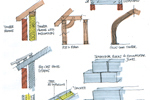Tutorial 7 - Design and Construction .
 |
7.1 ‘Different Construction Types
|
Illustration 7.1 ‘Different Construction Types' shows some of the different construction types available in home construction. I have listed below some of the advantages and disadvantages of the main different types of home construction.
Timber Frame
Advantages:
- Post and beam construction lends itself to open planning, large storey height, feature windows, and can look fantastic when viewed from both inside and outside.
- Quick erection of a frame on site.
- Low embodied energy. Softwood is a renewable material and doesn't involve a lot of energy in production etc.
- Generally uses less fuel for heating.
- Now well established in the UK.
Disadvantages:
- Be aware of a long pre-start on site programme (prefabrication takes time).
- Not so flexible to change. It changes at a later stage.
- Difficult to incorporate insulation if using a post and beam type construction.
- Need to use specialists who are aware of, and understand, the frame system.
- Timber frame does not lend itself to basement or underground construction.
- Can be difficulties with internal fixings, brackets, shelves, kitchen units.
Traditional Construction
Advantages:
- Durability.
- Longevity of life.
- Robustness.
- Permanence.
- A more solid feel, better from a noise transmission perspective.
- Greater flexibility for change.
- Opportunity to use solid floors between ground, first or second floor levels.
- New technologies give traditional home construction a great future.
Disadvantages:
- Traditional brick / block tend to be slower on site (new technologies are altering this).
- Traditional cavity construction struggles to meet new building regulation insulation standards; again, new systems will help with this in the future.
Permanently insulated formwork (PIF). This involves the use of formwork or shuttering to form concrete walls. The formwork or shuttering stays in place and provides insulation which is later clad in whatever material one requires inside or outside.
Advantages:
- Creative designs can be produced; curves, basement, storey-height windows.
- Very high performance in terms of fire safety, acoustic and insulation.
- Well tried and tested in Europe.
Disadvantages:
- Specialist, experienced labour force required.
- Relatively heavy on foundation loads.
Underground Homes and Basements .
Advantages:
- Basements and underground homes can provide persuasive arguments to Local Planning Authorities. There is an opportunity for a 3-level bungalow!
- The opportunity of extra space (sometimes significantly increasing home value.)
- Better energy savings than other designs.
- Low maintenance, greater security and generally lower fire risks.
Disadvantages:
- Can be dark!
- Involves a high level of skill and time leading to higher construction costs.
- Potential for things going wrong is greater than with other forms of construction.
Other Frame Buildings . There isn't time in this article to cover the great number of frames and other domestic construction systems. I have therefore just listed some of the main systems that are available. You will have to buy my book How to Design Your New Home, Extension or Alteration , coming out in the Autumn of this year, in order to read more!
- Steel frame
- Glue Lam, i.e. glue laminated timber is a series of thin sections of timber laminated together with a specialist glue to provide large, long span beams.
- Concrete frames. Reinforced concrete, i.e. concrete poured over steel reinforcing bars is used instead of load bearing steel, studwork or masonry.
- Other domestic construction systems:
- Straw bales usually laid on edge and anchored with steel pegs. The outside surfaces are usually covered in a mesh and rendered both inside and outside.
- Sprayed concrete. Usually involves reinforcing mesh bent into whatever shape is required. This is then sprayed with a specialist concrete applied by specialist method / contractor.
- Modular construction systems. The idea here is to build ones home in sections or pods and then to plug them together, minimising erection time on site.
- Don't forget other wall construction systems such us rammed chalk, cob walls, grid shells.
Conclusions :
- In all cases, proper planning ahead pays off. A good design will lead you into a sensible construction solution. The construction system will then often enhance the design.
- “Build tight, ventilate right”. This is a saying which is now used more and more in the building world. The idea is to seal up our buildings and control ventilation as opposed to allowing them to lose energy through draughts and gaps.
- Go for quality construction.
- Go for energy efficiency.
- Ensure adequate supervision on site.
- Be aware of the many options that are available to you as a homeowner in terms of construction type.
Suggested Reader Tasks :
- Through your local friends and contacts visit 3 homes all constructed in a different method, i.e. traditional masonry, timber frame, steel and glass.
- Record your first feelings; firstly on looking at the home from the outside, then when entering the home.
Contacts and References :
Go to www.homedesign-online.co.uk and www.homebuilding.co.uk .
|










